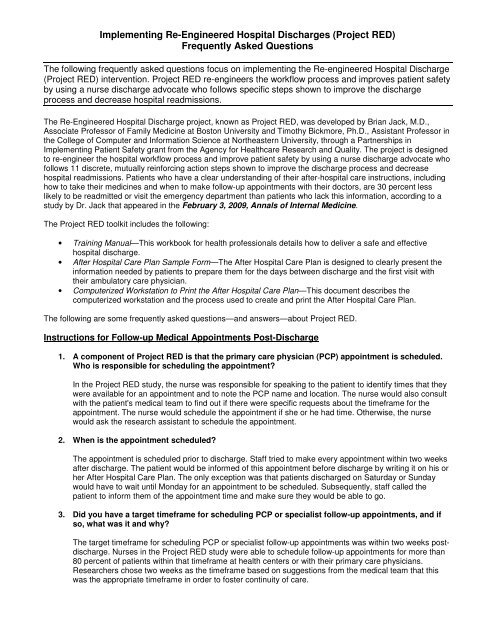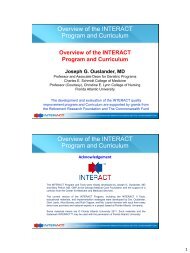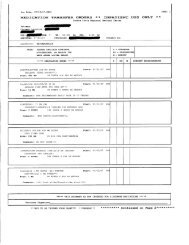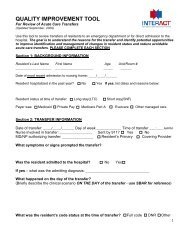Implementing Re-Engineered Hospital Discharges (Project RED ...
Implementing Re-Engineered Hospital Discharges (Project RED ...
Implementing Re-Engineered Hospital Discharges (Project RED ...
You also want an ePaper? Increase the reach of your titles
YUMPU automatically turns print PDFs into web optimized ePapers that Google loves.
<strong>Implementing</strong> <strong>Re</strong>-<strong>Engineered</strong> <strong>Hospital</strong> <strong>Discharges</strong> (<strong>Project</strong> <strong>RED</strong>)<br />
Frequently Asked Questions<br />
The following frequently asked questions focus on implementing the <strong>Re</strong>-engineered <strong>Hospital</strong> Discharge<br />
(<strong>Project</strong> <strong>RED</strong>) intervention. <strong>Project</strong> <strong>RED</strong> re-engineers the workflow process and improves patient safety<br />
by using a nurse discharge advocate who follows specific steps shown to improve the discharge<br />
process and decrease hospital readmissions.<br />
The <strong>Re</strong>-<strong>Engineered</strong> <strong>Hospital</strong> Discharge project, known as <strong>Project</strong> <strong>RED</strong>, was developed by Brian Jack, M.D.,<br />
Associate Professor of Family Medicine at Boston University and Timothy Bickmore, Ph.D., Assistant Professor in<br />
the College of Computer and Information Science at Northeastern University, through a Partnerships in<br />
<strong>Implementing</strong> Patient Safety grant from the Agency for Healthcare <strong>Re</strong>search and Quality. The project is designed<br />
to re-engineer the hospital workflow process and improve patient safety by using a nurse discharge advocate who<br />
follows 11 discrete, mutually reinforcing action steps shown to improve the discharge process and decrease<br />
hospital readmissions. Patients who have a clear understanding of their after-hospital care instructions, including<br />
how to take their medicines and when to make follow-up appointments with their doctors, are 30 percent less<br />
likely to be readmitted or visit the emergency department than patients who lack this information, according to a<br />
study by Dr. Jack that appeared in the February 3, 2009, Annals of Internal Medicine.<br />
The <strong>Project</strong> <strong>RED</strong> toolkit includes the following:<br />
• Training Manual—This workbook for health professionals details how to deliver a safe and effective<br />
hospital discharge.<br />
• After <strong>Hospital</strong> Care Plan Sample Form—The After <strong>Hospital</strong> Care Plan is designed to clearly present the<br />
information needed by patients to prepare them for the days between discharge and the first visit with<br />
their ambulatory care physician.<br />
• Computerized Workstation to Print the After <strong>Hospital</strong> Care Plan—This document describes the<br />
computerized workstation and the process used to create and print the After <strong>Hospital</strong> Care Plan.<br />
The following are some frequently asked questions—and answers—about <strong>Project</strong> <strong>RED</strong>.<br />
Instructions for Follow-up Medical Appointments Post-Discharge<br />
1. A component of <strong>Project</strong> <strong>RED</strong> is that the primary care physician (PCP) appointment is scheduled.<br />
Who is responsible for scheduling the appointment<br />
In the <strong>Project</strong> <strong>RED</strong> study, the nurse was responsible for speaking to the patient to identify times that they<br />
were available for an appointment and to note the PCP name and location. The nurse would also consult<br />
with the patient's medical team to find out if there were specific requests about the timeframe for the<br />
appointment. The nurse would schedule the appointment if she or he had time. Otherwise, the nurse<br />
would ask the research assistant to schedule the appointment.<br />
2. When is the appointment scheduled<br />
The appointment is scheduled prior to discharge. Staff tried to make every appointment within two weeks<br />
after discharge. The patient would be informed of this appointment before discharge by writing it on his or<br />
her After <strong>Hospital</strong> Care Plan. The only exception was that patients discharged on Saturday or Sunday<br />
would have to wait until Monday for an appointment to be scheduled. Subsequently, staff called the<br />
patient to inform them of the appointment time and make sure they would be able to go.<br />
3. Did you have a target timeframe for scheduling PCP or specialist follow-up appointments, and if<br />
so, what was it and why<br />
The target timeframe for scheduling PCP or specialist follow-up appointments was within two weeks postdischarge.<br />
Nurses in the <strong>Project</strong> <strong>RED</strong> study were able to schedule follow-up appointments for more than<br />
80 percent of patients within that timeframe at health centers or with their primary care physicians.<br />
<strong>Re</strong>searchers chose two weeks as the timeframe based on suggestions from the medical team that this<br />
was the appropriate timeframe in order to foster continuity of care.
4. Are the phone calls from the pharmacy and other post-discharge phone calls normally made by a<br />
nurse<br />
The phone calls from the pharmacist to the patient to discuss medications occur independently from any<br />
other post-discharge phone calls.<br />
Discharge Advocate<br />
5. What type of commitment is required from providers, nurses, and other hospital staff to make<br />
implementation successful<br />
The research study found that it is not only important for a majority of the providers, nurses, and other<br />
hospital staff to support the new process, but also that they commit to making the process successful.<br />
The type of commitment required by providers, nurses, and other hospital staff depends on several<br />
factors such as the hospital's patient population and patient needs, as well as the number of hospital<br />
personnel allocated to carry out the <strong>Project</strong> <strong>RED</strong> intervention.<br />
6. What is the ratio of the discharge advocate to discharge patient, and how many patients can a<br />
discharge advocate discharge per shift, on average<br />
In the <strong>Project</strong> <strong>RED</strong> study, the ratio of the discharge advocate to discharge patient was 1:2, and on<br />
average, one patient was discharged per day. However, because it was a research study, there were<br />
several factors that limited the ability of the discharge advocate to care for more patients:<br />
o Lack of staff: The discharge advocate typically worked six hours on the weekdays and five hours<br />
on the weekends (e.g., Monday through Friday from 8:00 a.m. to 2:00 p.m., weekends from 10:00<br />
a.m. to 3:00 p.m.) which is less than a typical eight-hour shift.<br />
o Time to generate After <strong>Hospital</strong> Care Plan: It took a considerable amount of time to generate the<br />
After <strong>Hospital</strong> Care Plan because the discharge advocate had to populate it manually (the<br />
electronic software to generate the After <strong>Hospital</strong> Care Plan was not available at the time).<br />
o Lack of integration with medical team: The discharge advocates were not integrated with the<br />
medical team. Therefore, they did not have access to the medical team's data on the patients and<br />
had to ask patients more questions than they would have otherwise.<br />
<strong>Re</strong>searchers anticipate that discharge advocates would be able to care for more patients in the normal<br />
hospital setting given that these research limitations would either not exist or they would be minimized.<br />
7. Does the discharge education associated with <strong>Project</strong> <strong>RED</strong> allow physicians to bill at a higher<br />
level<br />
Physicians can bill for two different levels of discharge education. In general, physicians who perform<br />
discharge education using <strong>Project</strong> <strong>RED</strong> can bill at the higher level (CPT Code 99239), which would allow<br />
them to bill approximately $32 more per discharge.<br />
8. How have providers, nurses, and other hospital staff responded to the use of the virtual discharge<br />
advocate<br />
<strong>Project</strong> <strong>RED</strong> has been well received so far. To understand nurse reaction, a brief test was conducted<br />
during an in-service for nurses. Half of the nurses received a briefing on <strong>Project</strong> <strong>RED</strong>, and the other half<br />
had a one-on-one interaction with one of the virtual nurses and performed some trust-building exercises.<br />
They had a personalized 10-minute chat with the virtual nurse. The test found that nurses with the<br />
opportunity for a one-on-one interaction were significantly more accepting of the system, more likely to<br />
recommend it to their patients, and felt significantly less threatened by it.<br />
9. Is the virtual discharge advocate technology only available as a stand-alone application or can it<br />
be built into other existing discharge planning programs a hospital may have<br />
The virtual discharge advocate technology is available as a stand-alone application and can also be built<br />
into other existing technology. The system can be integrated directly into the hospital information<br />
technology environment. In addition, staff training is available on how to deliver the discharge materials<br />
and information.
10. Was it necessary to enter all patient data at the nurses' workstation, or did the program interface<br />
with the hospital's electronic medical record (EMR) and pull in some information<br />
Currently, it is necessary to manually enter all data in the workstation. <strong>Project</strong> <strong>RED</strong> is working on<br />
integrating the software with the hospital electronic medical record, but that project has not been<br />
completed.<br />
Discharging Patients to Nursing Homes and Assisted Living Facilities<br />
11. What do nursing homes and assisted living facilities think of the discharge tools<br />
In some cases, <strong>Project</strong> <strong>RED</strong> study subjects were discharged to a nursing home. In such cases, nursing<br />
home personnel provided positive feedback, saying, "This After <strong>Hospital</strong> Care Plan is terrific. We used to<br />
only get the discharge summary, and it is very unclear from a discharge summary what we are supposed<br />
to do." The staff and the nursing homes benefited from a clearer presentation of what the patient needs to<br />
do, when the appointments are, what tests are pending, what the diagnosis is, how to follow up on any<br />
problems, and how to reach the clinician that is covering for them.<br />
It should be noted that the <strong>Project</strong> <strong>RED</strong> study did not enroll patients that were admitted from nursing<br />
homes, skilled nursing facilities, and rehabilitation centers for research purposes. However, the <strong>Project</strong><br />
<strong>RED</strong> intervention could be adapted to meet the needs of these patients and their care facilities.<br />
12. How do you best educate family members about discharge instructions when patients are being<br />
discharged to a nursing home or assisted living facility<br />
The <strong>Project</strong> <strong>RED</strong> research study found that the best way to educate family members about discharge<br />
instructions was through both the paper-based and electronic version of the After <strong>Hospital</strong> Care Plan.<br />
Often a nurse does not have time to provide education to a family member separately after he or she has<br />
already provided education to the patient. With the After <strong>Hospital</strong> Care Plan, an organization can provide<br />
family members the necessary information they need to take care of their elderly relative. Using the<br />
electronic version of <strong>Project</strong> <strong>RED</strong>, a nursing home can simply invite family members to sit and meet<br />
Louise, the virtual discharge nurse, and go through everything that they need to know to take care of their<br />
elderly family member.<br />
Evaluation of <strong>Project</strong> <strong>RED</strong><br />
13. Have there been any post-discharge followup studies to determine if improvement has been<br />
sustained and gains maintained<br />
<strong>Project</strong> <strong>RED</strong> has collected hospital readmission data up to 90 days post-discharge. These data will be<br />
analyzed in the near future in order to answer this question. However, it has been observed that the vast<br />
majority of the readmissions occurred within the first 30 days after discharge. Therefore, this is a specific<br />
area in which <strong>Project</strong> <strong>RED</strong> investigators are interested given that no further intervention is provided after<br />
the pharmacist phone call, which occurs two to four days post-discharge.<br />
14. What software, electronic forms, and process ideas can be shared to test <strong>Project</strong> <strong>RED</strong> at other<br />
organizations<br />
<strong>Re</strong>searchers tested <strong>Project</strong> <strong>RED</strong> by tracking various process and patient outcome measures. In order to<br />
better understand how well staff were using <strong>Project</strong> <strong>RED</strong> to discharge patients, researchers examined a<br />
variety of process measures, including the number of patients who received the After <strong>Hospital</strong> Care Plan,<br />
instruction from the discharge advocate, follow-up telephone calls, as well as the number of patients who<br />
had their medications reconciled. <strong>Re</strong>searchers also reviewed various patient outcome measures,<br />
including patient satisfaction measures and hospital readmission rates.<br />
For additional information on the types of measures used to test <strong>Project</strong> <strong>RED</strong>, please review the following<br />
article: "A <strong>Re</strong>engineered <strong>Hospital</strong> Discharge Program to Decrease <strong>Re</strong>hospitalization. A Randomized<br />
Trial," by Brian W. Jack, MD, et al., in the February 3, 2009, Annals of Internal Medicine, 150(3), pp. 178-<br />
187.
Cost and Implementation of <strong>Project</strong> <strong>RED</strong><br />
15. Is the After <strong>Hospital</strong> Care Plan a retail software product How much does it cost to purchase and<br />
implement<br />
The software to create the After <strong>Hospital</strong> Care Plan is available for purchase and implementation at your<br />
organization.* The cost of the software varies based on multiple factors including, but not limited to, the<br />
size of your organization, the extent of training and support required, if your organization wants to<br />
integrate the After <strong>Hospital</strong> Care Plan into an existing electronic medical record, and if your organization<br />
wants to purchase the Virtual Discharge Advocate technology (i.e., the electronic version of <strong>Project</strong> <strong>RED</strong>).<br />
With the electronic version of <strong>Project</strong> <strong>RED</strong>, the amount of time the nurses need to teach the After <strong>Hospital</strong><br />
Care Plan is greatly reduced.<br />
For more information or if you are interested in implementing <strong>Project</strong> <strong>RED</strong> in your organization, please<br />
visit the <strong>Project</strong> <strong>RED</strong> Web site at http://www.bu.edu/fammed/projectred/.<br />
*Boston Medical Center/Boston University School of Medicine has developed this product using professional and scientific methods, sources,<br />
and up-to-date clinical standards at the time of publication to confirm that the information contained in it is both reliable and valid. However,<br />
Boston Medical Center/Boston University School of Medicine and AHRQ caution that the product is to be utilized using the professional<br />
judgment of authorized physicians or nurses and staff directed and supervised by them. Each health care professional who decides to use this<br />
product or its content should understand that such use would be on the basis of that provider's professional judgment with respect to the<br />
needs and characteristics of the particular patients they are caring for. Boston Medical Center/Boston University School of Medicine and<br />
AHRQ disclaim any and all liability for adverse consequences or for damages that may arise out of or be related to the professional use or<br />
application by practitioners of the product or its content, including but not limited to, indirect, special, incidental, exemplary, or consequential<br />
damages. Furthermore, practitioners should be cautioned that professional and scientific methods and standards evolve over time. Therefore,<br />
attention should be given to possible progress in medical standards, techniques, and technology occurring after the production of this material.<br />
Current as of June 2009<br />
Internet Citation:<br />
<strong>Implementing</strong> <strong>Re</strong>-<strong>Engineered</strong> <strong>Hospital</strong> <strong>Discharges</strong> (<strong>Project</strong> <strong>RED</strong>): Frequently Asked Questions. Agency for Healthcare <strong>Re</strong>search and Quality,<br />
Rockville, MD. http://www.ahrq.gov/news/kt/red/redfaq.htm







